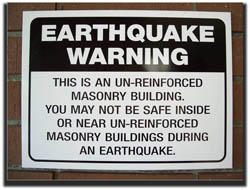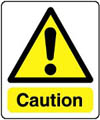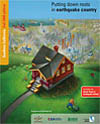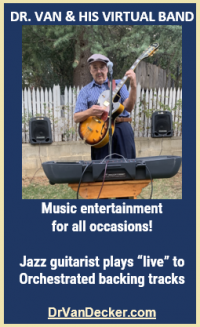
February 17, 2010 (San Diego's East County) --- Early last Sunday morning, a magnitude (M)4.5 earthquake along with subsequent aftershocks struck Baja California, Mexico. It was felt in East County and as far north as Oceanside.
Although we experience these temblors often, it is beneficial to know what to do if we find ourselves inside a building while at work, enjoying a meal at a restaurant, taking in the latest blockbuster movie at the theatre, or cheering on our favorite team in the stadium.
Drop, Cover and Hold On
It may be the natural tendency for some to run out of a building during an earthquake however, many have been injured because of being tripped up or struck by falling debris.
Federal, state, and local emergency management experts and other official preparedness organizations all agree that "Drop, Cover, and Hold On" is the appropriate action to reduce injury and death during earthquakes.
1.Drop 2.Cover 3.Hold On, seek shelter under a table (do not try to run to another room just to get under a table), between a row of seats or crouch in an inside corner of the building. The main point is to not try to move but to immediately protect yourself as best as possible where you are. Earthquakes occur without any warning and may be so violent that you cannot run or crawl; you therefore will most likely be knocked to the ground where you happen to be.
A Friendly Reminder to our Family and Friends
From time to time, it may be necessary to remind our family and friends (neighbors as well) of these important steps so that they will know what to do when a seismic event occurs. Remember, Drop, Cover and Hold On is applicable in any building you may find yourself in.
Fact or Friction?
Is it Safer Standing in a Doorway During an Earthquake?
An enduring earthquake image of California is a collapsed adobe home with the door frame as the only standing part. From this came our belief that a doorway is the safest place to be during an earthquake. True- if you live in an old, unreinforced adobe house. In modern houses, doorways are no stronger than any other part of the house. You are safer under a table.
Buying Waterfront Property in Arizona?
The idea of California falling into the ocean has had an enduring appeal. The motion of plates will not make California sink- western California is actually moving horizontally along the San Andreas fault and up around the Transverse ranges. As a result of this horizontal movement, Los Angeles City Hall is now 2.7 meters (9 feet) closer to San Francisco than when it was built in 1924. The rate of plate movement along the San Andreas fault, 33 millimeters (1.3 inches) each year, is about how fast your fingernails grow.
For more information about plate and fault movement
We Have Good Building Codes So We Must Have Good Buildings
The best building codes in the world do nothing for buildings built before a code was enacted. While the codes have been updated, the older buildings are still in place. Fixing problems in older buildings -- retrofitting -- is the responsibility of the building's owner
For more information about common building problems and earthquake insurance
Is the Triangle of Life an Alternative to Drop, Cover and Hold? No!
 In recent years, an e-mail has been circulating which describes an alternative to the long-established "Drop, Cover, and Hold On" advice. The so-called "triangle of life" and some of the other actions recommended in the email are potentially life threatening, and the credibility of the source of these recommendations has been questioned.
In recent years, an e-mail has been circulating which describes an alternative to the long-established "Drop, Cover, and Hold On" advice. The so-called "triangle of life" and some of the other actions recommended in the email are potentially life threatening, and the credibility of the source of these recommendations has been questioned.
For more information about the Triangle of Life
Additional Earthquake Resources and Real-Time Seismic Information
All of the literature listed can be downloaded or ordered for free.
 The information above was taken from, "Putting Down Roots in Earthquake country". This popular 32-page earthquake science and preparedness handbook was first published in 1995 by the Southern California Earthquake Center. SCEC and the Earthquake Country Alliance now update the handbook yearly, and it is now available in both English and Spanish.
The information above was taken from, "Putting Down Roots in Earthquake country". This popular 32-page earthquake science and preparedness handbook was first published in 1995 by the Southern California Earthquake Center. SCEC and the Earthquake Country Alliance now update the handbook yearly, and it is now available in both English and Spanish.
The San Francisco Bay Region version was developed in 2005 by the USGS and a large group of other organizations.
- California Earthquake Authority
- California Emergency Management Agency
- County of San Diego Office of Emergency Services
- Earthquake Country.Info
- FEMA
- Great California Shakeout - The largest statewide earthquake drill in the U.S. a great resource for research, businesses, organizations, press releases and public education.
- Earthquake Information in Other Languages
- Contact information for American Sign Language
- Spanish Resources and Literature - terremotos.org
- Video: 30 second Public Service Announcement "Showdown, Don't Fight a Brick"
What in the World is going on?
Google Earth makes it possible for you to view real-time seismic activity each placemark contains data about a specific area's seismic activity and a link to more extensive info.
Google Earth 5
Real-Time Earthquakes add in- U.S. Geological survey
Did You Feel That?
Report an earthquake and add to the statistical data that the USGS collects on a specific seismic event.
Did You Feel It? - Home Page
Stay informed- Free Registration
Email Alerts
East County Magazine’s Viejas Wildfire & Emergency Alerts
Text/cell phone Alerts:
ViejasAlerts via text/cell phone at www.Twitter.com
Text Message Alerts
KNX 1070AM – Los Angeles Radio News Station
San Diego Union Tribune
Email Alerts
East County Magazine’s Viejas Wildfire & Emergency Alerts
Alert San Diego - Ready San Diego
Sign up your cell phone to get reverse 911 calls – Spanish also
For More Information please contact:
Tod Aubin
Call or Text 619-518-8980
tod@prepare4.org
Web Page: http://prepare4.org
Safety Tweets: http://twitter.com/Prepare4_Org








Recent comments